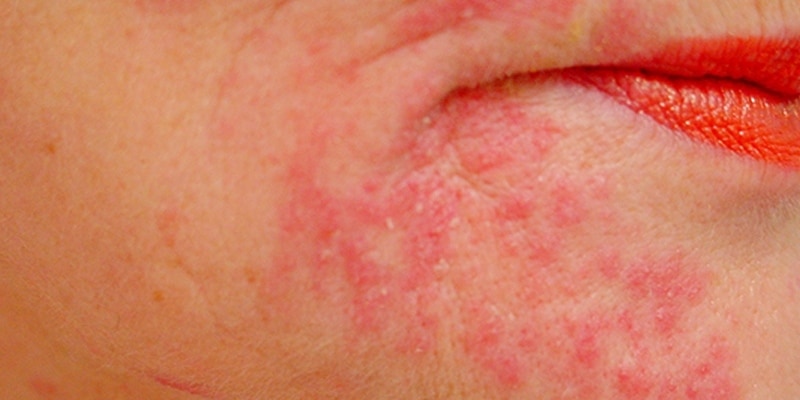Cosmetics are often used in daily life, and their use keeps increasing. Cosmetics are a mixture of several substances that are applied to the outer surface of the body to cleanse or perfume. Close cosmetic contact with the skin for a long time can initiate sensitization of chemicals and cause allergic contact dermatitis (DKA).
Dermatitis due to cosmetics occurs in 2-4% of all cases of contact dermatitis found in the clinic. The chemicals contained in cosmetics can initiate the process of skin sensitization. Reactions to cosmetics usually occur in patients with a history of sensitive skin or atopy. The products that most often cause DKA are skincare products, moisturizers, makeup, and hair care products. However, DKA can also be caused due to perfume, deodorant, and toothpaste.
A retrospective study conducted at Outpatient (IRJ) Installation of Dermatology and Venereology Health Dr. Soetomo Surabaya from 2014 to 2017 found that there were 289 (26.1%) cosmetic contact dermatitis patients. The incidence of DKA increases significantly every year. Allergic contact dermatitis is common in women (93.4%), aged 20-30 years (37.7%). The most common cause of cosmetic contact dermatitis patients in this study is morning cream/sunblock with 101 patients and night cream with 95 patients, followed by face powder and soap. The most frequent clinical manifestations are erythematous macules, papules, and squama, while the symptoms most often experienced by patients are itching and burning sensation on the skin. Cosmetic contact dermatitis patients who had a history of atopy were 19.7%, and in 6.5% of patients had history of atopy from their family.
Another study mentioned that the most common causes of contact dermatitis due to cosmetics are fragrances, preservatives, and hair dye products. Preservatives mixed in cosmetic products can cause clinical manifestations in contact dermatitis due to cosmetics. The most commonly used preservatives are parabens which have stable constituents and low risk of allergies in healthy skin, formaldehyde releasers, and isothiazolinones. Formaldehyde is one of the allergens used in some cosmetic products. The prevalence of allergies to formaldehyde in the United States is 8-9%, and 34% of them also have allergies to formaldehyde-releasing agents.
Apart from chemicals, some contact dermatitis due to cosmetics is also caused by natural ingredients, such as almonds, wheat, soybeans, and nuts. Most often used natural ingredients from plant extracts causing allergies are tea tree oil and derivatives from the Compositae and Asteraceae family. As not all natural ingredients are listed in the composition of cosmetic products, education for patients to avoid all cosmetic ingredients, including natural ingredients, must be done.
Allergic contact dermatitis due to lip dyes occurred in 9 patients in 2014-2017 at the IRJ Dermatology and Venereology Health Dr. Soetomo Surabaya. One of the ingredients in lip dyes reported causing DKA is gallates. Gallates is the main component of an antioxidant that protects other molecules to fight the effects of free radicals, prevents oxidation, and prevents a cosmetic product from deforming the shape and odor. Rashes/efflorescences that appear in patients with contact dermatitis due to cosmetics are erythematous macules, papules, squama, erythema, plaque, macules, vesicles, and pustules. Secondary lesions can also be found, such as hyperpigmentation, hypopigmentation, crust, and excoriation. As for the clinical symptoms are strongly influenced by the type of product, area of application, and duration of contact.
Patients with a history of atopy tend to develop IgE sensitization to several proteins such as pollen, food, and animal products. This tendency occurs because patients with a history of atopy or atopic dermatitis also have skin barrier dysfunction and an increased risk of allergen protein sensitization through contact with the skin. From the patch test showed that 37.7% of patients had positive results. However, because not all antigens in cosmetic products have a standard reagent for patch testing so sometimes the patch test results do not match clinical conditions. Fragrance mix I is the material most often causes allergies in 70-80% of cases. Some of this material contains 5% sorbitan sesquioleat to improve the perfume dispersion.
The main treatment for contact dermatitis due to cosmetics is the cessation of use and followed by supportive therapy following clinical symptoms. This supportive therapy includes oral administration of antihistamines, topical steroids, and oral steroids, and if there is a secondary infection then oral antibiotics should be given. Cosmetic products must be used carefully because they can cause allergic contact dermatitis with various clinical manifestations. Almost all cosmetic products can cause DKA either from preservatives or natural ingredients. When contact dermatitis due to cosmetics suspected, the use of the product must be stopped immediately and supported with some therapy.
Author: Prof. Dr. dr. Cita Rosita Sigit Prakoeswa, SpKK(K), FINS-DV, FAADV
Details of this research available at:
https://e-journal.unair.ac.id/BIKK/article/view/11044
Journal title: Profile of allergy contact dermatitis due to cosmetic products
Marissa Astari Rubianti, Cita Rosita Sigit Prakoeswa
Department of Dermatology and Venereology, Faculty of Medicine, Universitas Airlangga / Dr. Soetomo General Hospital, Surabaya, Indonesia





